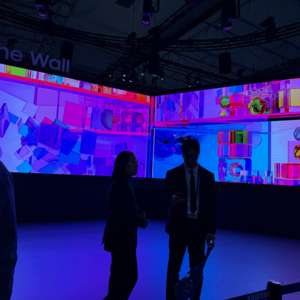In a move that signals Microsoft’s growing ambition in the workplace visualization space, the tech giant has rolled out Digital Signage capabilities for Teams Rooms – potentially reshaping how enterprises leverage their AV infrastructure for internal communications.
Digital Signage vs Digital Advertising
If you’re sitting here wondering what exactly is “digital signage” stay tuned. Or, if you know what digital signage is but wondering why we’re putting this here next to “digital advertising” also stay tuned.
Just like every industry, the world of AV has terms and acronyms we use. Sometimes, those terms aren’t used by anyone else. Ok? Digital signage is one of those. The advertising world refers to direct view LED screens with hi-res content as OOH or DOOH which stands for Out of Home or Digital Out of Home respectively.
It really doesn’t matter what the term is. The bottom line is some form of TV screen (I know, “display”) with messaging on it. For the purposes of this article we’re going to refer to that as digital signage. On with the show.
The Integration Play
At its heart, the new Digital Signage feature transforms dormant Teams Rooms displays into dynamic content delivery points, marking a significant shift from traditional meeting room functionality. While competing solutions have offered similar capabilities, Microsoft’s integration into the Teams ecosystem could prove to be a game-changer for AV managers looking to consolidate their technology stack.
What we’re seeing here is the natural evolution of unified communications. Microsoft isn’t just adding features – they’re redefining the ROI proposition for meeting room displays by essentially doubling their utility. That means if you want to put a bigger, better screen in the conference room, go ahead. We have financial reasons for doing so now.
Technical Specifications and Implementation
The solution operates through the Teams Admin Center, offering:
- Content playlist management
- Location-specific messaging
- Scheduling capabilities
- Remote administration
- Weather integration
- Corporate communications tools
The implementation process appears straightforward, requiring minimal additional hardware investment for existing Teams Rooms setups. This could prove particularly attractive for enterprises already invested in the Microsoft ecosystem.
Market Impact and Industry Implications
This move positions Microsoft more directly against dedicated digital signage solutions providers, potentially disrupting the traditional AV market segmentation. This while Amazon has also gotten into the digital signage market. For facilities running mixed environments, the ability to manage signage through the same interface as their meeting rooms could simplify workflows and reduce training overhead.
The Enterprise Perspective
From an enterprise standpoint, the value proposition is compelling:
- Maximized display utilization
- Reduced communication channel fragmentation
- Centralized content management
- Simplified administrative overhead
- Future integration potential with Power BI and emergency systems
AV Manager’s Toolkit
The system offers several key features that AV managers should note:
- Remote management capabilities
- Customizable content scheduling
- Room-specific targeting
- Integration with existing Teams Room management tools
Future Roadmap
Microsoft’s hints at future Power BI integration suggest a broader vision for enterprise visual communications. The potential for real-time data dashboards and emergency alert system integration could make this platform particularly valuable for corporate environments where information display needs extend beyond basic signage.
What you need to know today
This development represents a significant step forward in the convergence of UC and digital signage technologies. While dedicated signage solutions may offer more sophisticated features, the seamless integration with Teams Rooms provides a compelling proposition for organizations looking to maximize their AV investment and streamline their technology stack.
For AV managers and integrators, this update deserves serious consideration, particularly in environments where Teams already forms the backbone of collaboration infrastructure. The ability to leverage existing hardware and management tools could provide significant cost advantages over standalone signage solutions.
The integration possibilities with Power BI and emergency systems suggest this is just the beginning of Microsoft’s ambitions in the enterprise display space. AV professionals would do well to keep an eye on future developments in this area.
Tim Albright is the founder of AVNation and is the driving force behind the AVNation network. He carries the InfoComm CTS, a B.S. from Greenville College and is pursuing an M.S. in Mass Communications from Southern Illinois University at Edwardsville. When not steering the AVNation ship, Tim has spent his career designing systems for churches both large and small, Fortune 500 companies, and education facilities.









